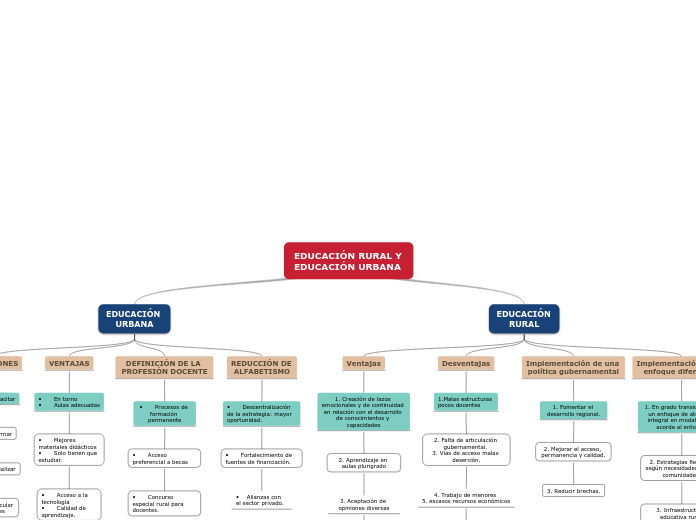by Dario Alexander Canchala Salcedo 5 years ago
1309
EDUCACIÓN RURAL Y EDUCACIÓN URBANA

by Dario Alexander Canchala Salcedo 5 years ago
1309

More like this
Type in the name of the multiple-perspectives text.
Example: Bridge to Terabithia by Katherine Paterson
2. Estrategias flexibles según necesidades de las comunidades.
3. Infraestructura educativa rural.
2. Mejorar el acceso, permanencia y calidad.
3. Reducir brechas.
2. Falta de articulación gubernamental. 3. Vias de acceso malas deserción.
4. Trabajo de menores 5. escasos recursos económicos
6. no material didáctico. 7. No hay acceso a la tecnología
Type in a relevant quote that highlights the character's point of view towards
EDUCACIÓN RURAL.
Try following a citation format: author's name, chapter, and page.
Example: 'Jesse drew the way some people drank whiskey. (...) Lord, he loved to draw. (...) When he was in first grade, he told his father that he wanted to be an artist when he grew up.' (Paterson, 2. 7)
2. Aprendizaje en aulas plurigrado
3. Aceptación de opiniones diversas
4. Docente con autonomía el uso y gestión
5. Numero reducido de alumnos.
Identify an important issue from the text that is being presented from different angles. Type it in.
Example: Jesse's drawing talent.
Decide on the fourth point of view
Type in the name of the last character whose perspective on the issue you are going to present.
Example: Leslie Burke, Jesse's new next-door neighbor, and best friend.
Point of view
Type in a relevant quote that highlights the character's point of view. Try to follow a citation format: author's name, chapter, and page.
Example: I can't get the poetry of the trees,' he said. She nodded. Don't worry,' she said. You will someday. He believed her.' (Paterson, 4. 24)
• Fortalecimiento de fuentes de financiación.
How is the viewpoint introduced in the story?
Choose an answer:
• Alianzas con el sector privado.
Whose character does the third point of view belong to?
Type in his/her name.
Example: Mr. Aarons, Jesse's father.
What does the character think, say or do that suggests their perspective on the issue?
Type in a quote and try to maintain the citation format.
Example: 'He would like to show his drawings to his dad, but he didn't dare. (...) He'd thought his dad would be pleased. He wasn't. What are they teaching in that damn school? he had asked.' (Paterson, 2.8)
• Acceso preferencial a becas
What kind of narration introduces the viewpoint?
Choose an answer:
• Concurso especial rural para docentes.
Decide on the second point of view
Name the character (it can either be the main character or one of the supporting characters) whose point of view you are presenting.
Example: Miss Edmunds, Jesse's music teacher.
Type in a quote that points out the character's position about the issue.
Try to follow a citation format: author's name, chapter, and page.
Example: 'She said he was unusually talented, and she hoped he wouldn't let anything discourage him.' (Paterson, 2. 8)
• Mejores materiales didácticos • Solo tienen que estudiar.
How is the viewpoint introduced in the story?
Choose an answer:
• Acceso a la tecnología • Calidad de aprendizaje.
• La familia acompaña al estudiante. • Cuentan con afecto • Acceso a la alimentación, salud y socialización.
Decide on the first point of view you are going to present.
Type in the name of the character (it can either be the main character or one of the supporting characters) whose point of view belongs to.
Example: Jesse Oliver Aarons, Jr., the main character of the novel, a fifth-grader living in a rural Southern area.
Type in a relevant quote that highlights the character's point of view towards
EDUCACIÓN URBANA.
Try following a citation format: author's name, chapter, and page.
Example: 'Jesse drew the way some people drank whiskey. (...) Lord, he loved to draw. (...) When he was in first grade, he told his father that he wanted to be an artist when he grew up.' (Paterson, 2. 7)
• Formar
What type of narration introduces the viewpoint?
Choose an answer:
• Socializar
• Vincular valores
• Estructurar conocimientos